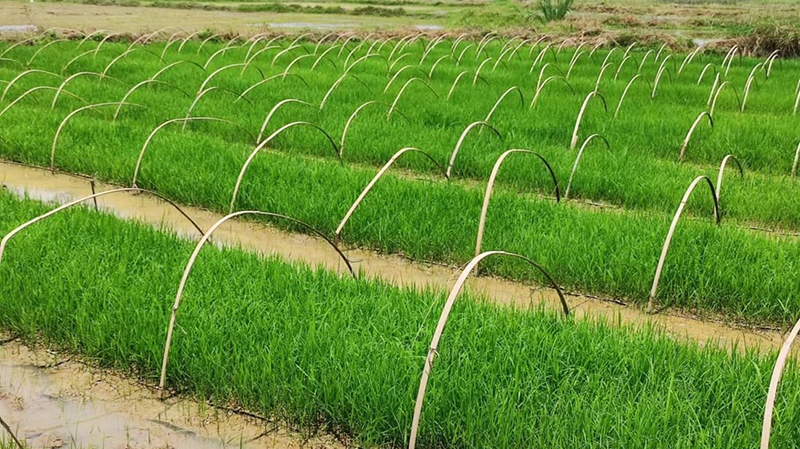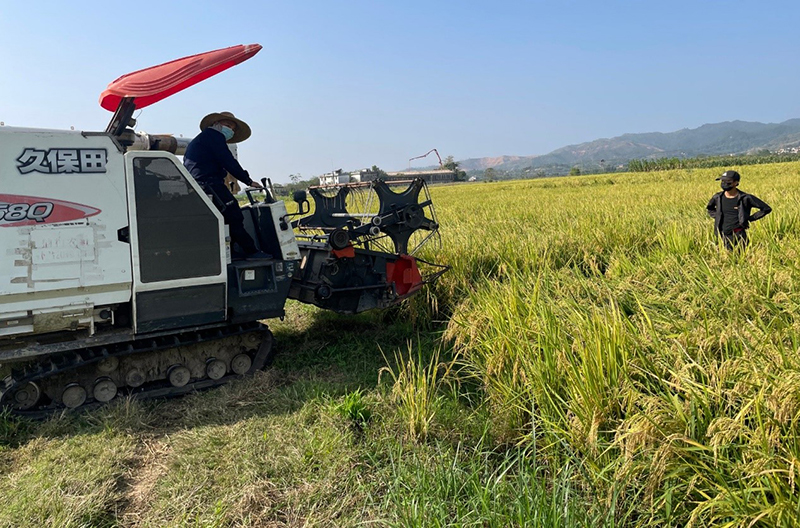Why Chinese farmers choose perennial rice l SCMP
2022-12-13

The total planted area of perennial rice in China in 2021 was over 15,000 hectares
When Liang Yuxin first heard about a new rice variety that could be harvested for years without replanting, he was eager to try it out.
If his experiment was successful, it would give confidence to local farmers, said Liang, the representative of a farmers’ cooperative in China’s southwestern region of Guangxi.
“There are many plots lying fallow in the rural areas of southern China and the planting cost is high. But if I can plant rice once and reap harvests for several years, the cost will be greatly reduced,” Liang said. “Why won’t I try it?”

Liang Yuxin (left) planted more than 1 hectare of perennial rice in the southwestern province of Guangxi
Liang is one of more than 40,000 small farmers in China who have
chosen to plant this new kind of rice.
Developed by researchers from Yunnan University over two decades, the perennial rice variety has not only demonstrated yield potential, but also lowered costs and enhanced soil quality, according to a study published recently in the peer-reviewed journal Nature Sustainability.
The researchers crossed an Asian domesticated annual rice cultivar with a wild perennial African variety to create a new hybrid, which they called Perennial Rice 23 (PR23).
Its yield has been shown to be slightly higher than that for annual rice for the first four years, at an average of 6.8 tonnes per hectare (2.5 acres) per season, compared to 6.7 tonnes of the replanted variety.
While the costs are similar for both kinds of rice in the first season, the perennial variety does not need seeding, planting and ploughing for several years, which means farmers can save up to US$1,400 per hectare in subsequent season.
Overall, perennial rice can cut labour costs by 60 per cent and halve input costs for each regrowth cycle. The net economic benefits can range from 17 per cent to as much as 161 per cent above annual rice in different planting locations, according to the authors of the study.
PR23 was made commercially available for Chinese farmers in 2018 and was among the 29 varieties recommended to them by the Ministry of Agriculture and Rural Affairs earlier this year.
Last year, the total planted area of perennial rice in China was over 15,000 hectares, four times higher than in 2020.
Liang planted another perennial variety, the PR25, across more than 1 hectare in August and harvested over 8 tonnes three months later.
“We have confidence in perennial rice,” said Liang, who aims to further expand his area of cultivation.
“Normally it is very hard to earn money by growing rice. But after planting perennial rice, I am pleased that [we can] make some money if we manage it well. It will be a great boon to farmers if its cultivation is promoted.”

Harvesting under way for perennial rice after the first growing season in Guangxi
Erik Sacks, professor in the crop sciences department at the University of Illinois Urbana-Champaign and co-author of the study, said less frequent ploughing in the perennial rice system conserved soil and built organic matter content.
“Soils with high organic matter are more productive than soils with low organic matter because the organic matter can loosely hold onto plant nutrients and make them available for crop growth,” he explained.
Growing perennial rice also saved water, as less water was needed to obtain “ratoon crops” – or second harvests – of rice, compared with getting a new crop from seeds or transplanted seedlings, Sacks added.
Lead author Zhang Shilai, professor at Yunnan University’s School of Agriculture, said the team will continue to work on developing cold-tolerant, heat-tolerant, and disease-resistant varieties so that they can be promoted over larger regions.
“We promoted perennial rice across Yunnan and addressed the key issues that matter most to farmers: yields, costs, taste and stable production across multiple seasons. Many of these farmers grow rice as a staple food for their families, so perennial rice must compete against other rice varieties,” Zhang said.
In April, Yunnan University and genomics organisation BGI Group set up a perennial rice joint venture, focusing on large-scale localisation.
However, the study also noted challenges with pests, disease and weeds, which might be easier to control in annual crops.
“But perennial rice is still a very new crop, and we predict that cropping systems and pest-resistant varieties will be developed,” said Tim Crews, study co-author and chief scientist at The Land Institute, a Kansas-based non-profit organisation.
The new perennial varieties hold special significance for China. The world’s most populous country is also its top consumer of rice, accounting for about 30 per cent of total global demand.
Source: South China Morning Post
Additional Reading
Why BGI's perennial rice can be a game changer for farmers in China and beyond l SCMP
Perennial rice incorporates African wild rice genes and halves production cost l BGI Perspectives
About BGI Genomics
BGI Genomics, headquartered in Shenzhen China, is the world's leading integrated solutions provider of precision medicine. In July of 2017, as a subsidiary of BGI Group, BGI Genomics (300676.SZ) was listed on the Shenzhen Stock Exchange. BGI has topped the Asia Pacific and China life science corporate institution ranking table for the seventh year running, released in the 2022 Nature Index Annual Tables.